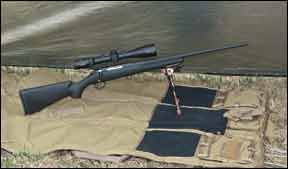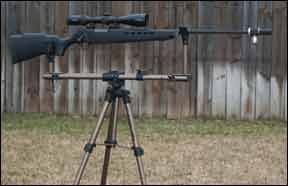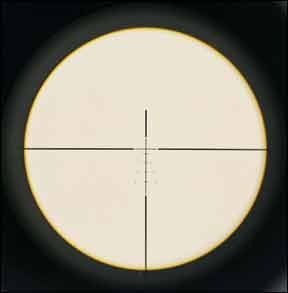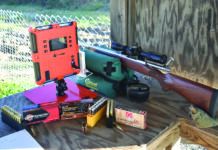In our test teams initial discussions about evaluating production bolt-action rifles, an interesting sideline emerged. One member of our test team owns a bolt-action rifle built by Roger David of Sulphur, Louisiana (Davids Gunshop, 337-527-5089). Evaluated in our November 2004 issue, it turned out to be a super-accurate rifle. And why not, considering it was hand-built by a master gunsmith and utilized the finest components. But in the last year or two, weve been seeing accuracy results from inexpensive assembly line rifles that come close to the performance of our most prized custom guns. Which leads us to two questions. First, how is that possible? The answer is computer numerically controlled (CNC) machining and new methods of computer-aided design.

Our second question was, if we were to choose a couple of these new bolt-action rifles that sell for less than $500, would they really perform at a level of accuracy that just as few years ago would be much more costly in terms of time and money? To see if todays rifle shooters really are being treated to superior accuracy at a bargain price, we decided to test two synthetic-stocked rifles from Ruger and Mossberg. Our choice of cartridge was 243 Winchester because of its reputation of delivering more than adequate power to take down deer while disturbing a minimum amount of meat. Plus, 243 Win. is an effective choice for hog and coyote hunting. Our rifles were the $449 Ruger American and the $471 Mossberg 4X4. Both rifles are lightweight hunting models fitted with black synthetic stocks, matching blued barrels with recessed crowns, pre-mounted two-piece scope bases, sling attachments front and rear, rubber buttpads, and removable box magazines. Barrel lengths for the Ruger and Mossberg rifles were 22 inches and 24 inches, respectively.
To give our budget rifles the opportunity to excel, we chose a little more scope than might be found on an everyday hunting rifle. The new Steiner Predator Xtreme model 5003 offered 4-16X variable power with a 50mm objective lens. Built on a 30mm tube, it measured 15 inches in length and weighed 22 ounces. Side parallax adjustment was calibrated from 50 yards to 500 yards to infinity. Click-adjustment value was MOA. We counted 240 total clicks of elevation and 200 clicks of windage from lock to lock. The Steiner Plex S1 is a second-focal-plane reticle that offers ballistic lines for holdover calibrated for most popular calibers and bullet weights. Stick-on reference charts are supplied. In addition, the hold-over lines were bordered by a series of cascading dots to the left and right to help compensate for wind. The dots are calibrated for a 10-mph wind value, according to the owners manual. We found the added visual reference to be useful and clear. The Steiner Predator Xtreme comes with a 30-year warranty.

After successfully mounting the Steiner on the Mossberg rifle, we couldnt get the scope to stay seated atop the Ruger. Measuring the interior dimensions of the slots on the Mossbergs scope mounts we found that rear notch on the Mossberg measured only 0.146 inches wide, but the two notches on the front base were larger, measuring only about 0.150 inches across. Whereas the mounts didnt match, they still were able to provide a good enough fit for the thin, round cross bolts of our Leupold Rifleman rings. The Rugers cross-slots were uniform but wider, measuring about 0.156 inches across. Switching to a set of Warne Maxima rings (No. 215M), which utilize rectangular lugs for seating, solved the mounting problem.
To test, we chose ammunition topped with four bullet weights. They were Black Hills Gold 85-grain Barnes TSX, Winchester Super X 80-grain Pointed Soft Point, Black Hills Gold 62-grain Varmint Grenade, and 58-grain Hornady Varmint Express ammunition. Each rifle was tested for accuracy from a bench. We shot at targets located 100 yards away. Heres how our rifles performed:
Ruger American No. 6904 243 Winchester, $449
The Ruger American rifle is currently chambered for 270 Winchester, 30-06 Springfield, and 308 Winchester as well as our 243. Two guns were listed as weighing 6.25 pounds; the 308 was listed at 6.12 pounds. The 243 fires through a 1:9-inch-twist hammer-forged barrel, but the others are fit with 1:10-inch twists. Otherwise, specifications and the suggested retail price for each model was the same.
Early on, our eyes were drawn to the trigger and bolt. The three-lug 70-degree bolt was the only chromed piece, and the somewhat short handle was fit with a large ball that rested almost directly above the trigger. The trigger itself showed an extra lever, much like were accustomed to seeing on some semi-automatic pistols. This is Rugers Marksman adjustable trigger. The hinged section that was seated inside the trigger face was referred to as the trigger release. To move the trigger rearward, this flat skeletonized panel needed to be compressed against the face of the trigger.
Holding the American for the first time our immediate impression was how narrow the stock was, especially at the buttstock. This allows the mount at the comb to be entirely neutral for left- and right-handed shooters. Ruger nevertheless ships each rifle with a card redeemable for a free cheek pad. The pad is designed to add height and softness to the stock as well as a side pocket and cartridge loops. We judged the buttstock to be entirely suitable as we found it. Elsewhere, the buttstock pad was soft and thick. The forend grip was enhanced by an inlet contour, where it bordered the free-floated barrel. We thought the pistol grip was slender as well, but not quite thin enough to be considered anything other than neutral. The safety was located atop the pistol grip at the center of the tang.
Beyond cleaning and oiling the barrel, there was one additional maintenance point available to the owner. This was lubrication of the dual cocking cams located beneath the polymer sleeve that covers the tail end of the bolt. The bolt is removed by depressing the release located on the upper left side of the receiver. We found if you draw back the bolt and then press the release, the bolt tends to catch and prevent removal. Rotating the bolt slightly will free the bolt, but its a sticky proposition. We think a more efficient method to remove the bolt was to press the release lever while the bolt is still fully forward. It makes no difference if you begin with the bolt handle up or down, just so long as you have already removed the magazine and pulled the bolt rearward to inspect the chamber.
To expose the cocking cams, the section of the bolt directly behind the bolt handle needed to be twisted clockwise about one-quarter turn so that the cocking flat lines up with the black square seated flush with the surface of the bolt. The black polymer sleeve can now be removed. The cams may be periodically lubricated with light viscosity oil. This ensures that bolt action will remain smooth. Twisting the tail-cap counter clockwise until it snapped shut required less effort than opening it.
The flush-fit four-round magazine was compact. The release latch was located on the magazine itself, much like the design found on Steyr rifles. At first we found loading the magazine to be a little odd. Normally, we expect to either press directly downward or slide the round case rim first over the follower. In this case, the first round needed to swing the follower out of the way instead of downward. After the first round was in place, with a little twisting and probing we were able to press down and slide the rounds easily into place front to rear. The reason for the unexpected learning curve was that the Ruger American magazine is something of a hybrid rotary design. Rotary magazines generally accept rounds like cogs in a gear. But the interior of this magazine featured a spring-loaded panel. Once the gate was pushed aside, the rounds followed a track leading to the bottom of the magazine and then looped upward behind the hinge in a J-shaped track. Our testers found the bolt action to be smooth, and all rounds likewise fed smoothly from the magazine. Minor nit: Single-loading rounds into the chamber over the top of an empty magazine was not as reliable and required more care.

The Ruger Marksman trigger was adjustable. Loosening the two 3/16-inch Allen bolts to either side of the magazine well released the barreled action from the stock. This gave us a good look at Rugers Power Bedding blocks seated into the composite stock. The Allen-type trigger-weight adjustment screw was located at the front face of the trigger housing. It takes about 3 turns to change weight of pull 1 pound, and according to Ruger, you can turn it down or loosen it completely, and pull weight will only vary from about 3 pounds to 5 pounds of resistance. We left it at the weight it was received, requiring about of 3.75 pounds of pressure to break the shot. We found the trigger action, at any weight, displayed little or no take up and broke with a pleasingly crisp snap. An important point to remember when reseating the action into the stock is to remember that the two Allen bolts can be overtightened. Maximum pressure is about 75 inch-pounds. According to Ruger, it was probably safe to use a small hand wrench, thanks to the limited amount of leverage such a tool provides.
At the range the barrel was swabbed with a cleaner lubricant over the rough side of military patch material every 10 rounds. We found that accuracy improved after about 50 shots. We thought the accuracy results were remarkable. Our test shooter was able to land at least 1 sub-MOA five-shot group with all four choices of ammunition. The smallest average groups were achieved firing the two lighter bullets. This turned out to be a pattern followed by both rifles. Whereas the 85-grain and 80-grain rounds produced average size groups measuring about 1.2 inches and 1.1 inches respectively, the Black Hills Gold 62-grain Varmint Grenade rounds averaged just less than 1.0 inches for all shots fired. The 58-grain Hornady Varmint Express rounds produced an average sized group measuring only 0.70 inches across, with a best-of-test smallest group to be about 0.40 inches.
Our Team Said: Our team shooters said, Where do I get one of these? Over the course of one afternoon, we enjoyably fired more than 100 rounds. The Ruger American was comfortable and delivered performance that was worthy of a much more expensive rifle.
Mossberg 4X4 No. 27657 243 Winchester, $471
O.F. Mossberg and Sons of North Haven, Connecticut, has been synonymous with pump shotguns for so long one might be surprised to find out that the company offers as many as four different lines of bolt-action rifles. The 4X4 rifles, and the MVP lineup, both feed from removable box magazines and feature the LBA trigger. Whereas the MVP rifles are heavy and somewhat military in profile, the Mossberg 4X4 rifles are trim, handsome and shaped very much in the hunting tradition. The 4X4s are available chambered for 13 different cartridges, ranging from 22-250 to 7mm-08 Remington. Choices of stock include laminate, walnut (plain), and walnut sculpted. Our rifles stock was referred to as Synthetic Black Classic with a 24-inch fluted barrel. A plain-surface barrel measuring 22 inches in length was another option, as well as the new satin stainless MarineCoat. Five of the available 4X4 rifles can be purchased fitted with a variable power scope. Our black rifle could be considered the base model and was not available with mounted scope. Distinctive features such as the ventilated forend, Monte Carlo stock, and spiral-fluted bolt were standard on all 4X4s.
Our 4X4 had a more deeply recessed crown than the Ruger American. The barrel fluting began at the tip of the forend, so only about 11.5 inches of the free-floated barrel was actually cut. The synthetic stock had a solid feel except for the buttstock. The buttpad was about 0.8 inches thick at its center, and there were hollow portions beneath the surface to make it softer. The rubber pad was very grabby. Sling-swivel attachment points were integral front and rear. Their diamond-shape profile did not provide a solid point of contact for a traditional Harris-style bipod.
The pistol grip was round and very slender, but the seam where the two sides of the mold joined was noticeable. The left side of the buttstock was augmented with a cheek pad, but the grip itself was not biased with a palmswell on either side. Some of our staff would have preferred to build up the pistol grip to better index the finger to the trigger. The LBA or, Lightning Bolt Action, resembled the Rugers trigger, but the interior lever was relieved with a cutout of a lightning bolt. This acted as an extra safety and required compression before the trigger could be moved rearward. Trying to press the trigger without compressing the lightning bolt resulted in a short, halting movement that seemed to lock the action in half cock. To reset the trigger and make it ready to fire, the bolt handle needed to be lifted and returned to its down position.
The trigger was adjustable from about 2 pounds to 7 pounds. Access to the trigger-pull adjusting screw was gained by removing the action from the stock. This requires removing the two bolts fore and aft of the magazine well. The adjusting screw was, like the Ruger, located at the front of the trigger-group housing. For our tests, we left the trigger pull weight at 3.3 pounds as delivered. No matter how we changed the trigger pull weight, the action felt relatively the same. We had the sensation of a brief take up along with a sense of compression followed by the break.
The two-lug bolt was fluted with eight twisting lines that were blackened for contrast. The bolt handle was plain. Action was pleasingly smooth. Feeding rounds singly or from the magazine proved reliable and was never a chore. All basic manipulations were simple, straightforward, and proved trouble free.
The five-round magazine was easy to load, requiring a direct downward push of each round against what appeared to be a mild spring. The magazine release lever was attached to the front wall of the magazine well. The well itself was a polymer insert separate from the stock that not only contained the magazine but also served as an intermediary block to meld the action with the stock.
At the range, the Mossberg 4X4 produced a virtual tie with the Ruger in group sizes for three of our four test rounds. Like the Ruger American, our Mossberg shot its best single group firing the Hornady Express ammunition, measuring 0.70 inches wide. Not quite as accurate as the Ruger, our Mossberg did tie in regards to largest group at 1 MOA. Elsewhere, the Mossberg delivered slightly more energy because of the extra 2 inches of barrel length compared to the Ruger. The 4X4 propelled bullets as much as 100 fps faster on average in three of four choices of test ammunition. Testing the 22-inch-barrel 4X4 against the Ruger American would likely have provided a closer comparison, but only Mossberg offers the longer barrel as an option.
Our Team Said: We thought that the Mossberg 4X4 recoiled less or at least was the more comfortable rifle to shoot. The longer barrel launched rounds with more velocity and power, and we liked the easy-to-load magazine that carried an extra round. As rugged as the synthetic stock should be in harsh climates, we think choosing a 4X4 with a walnut or laminate stocks would make it even more comfortable to shoot and add visual appeal.
Written and photographed by Roger Eckstine, using evaluations from Gun Tests team testers. GT
0213-243-WIN-ACC-CHRONO-DATA.pdf




























